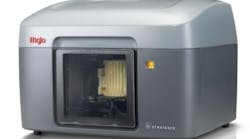When Scott Crump, CEO and co-founder of Stratasys Inc., invented fused deposition modeling (FDM) in 1989, he had one goal in mind: to design a system that would allow engineers to create high quality, low cost three-dimensional prototypes as easily as they could print two-dimensional descriptions of them.
With the announcement of its Mojo 3D Printing System -- the company's newest, smallest (and cheapest) desktop rapid prototyping machine -- it looks like he may have finally met that goal.
In a very real sense, the Mojo, released today by Stratasys, marks a new epoch in the 3D printing industry -- an epoch in which affordable, easy-to-use printers may enable more engineers to bring products from design to market faster and more efficiently than ever before.
This may sound like the usual 3D printing hysteria that surrounds releases like this, but, measuring only 25 inches wide and 18 inches tall and with a single layer resolution of .007 inch, the Mojo may actually live up to this game-changer hype.
The new printer actually contains a lot of new and innovative features like the integrated support removal system and replaceable heads, but there are two key points that promise to deliver on these claims more than any other: price and reliability.
Price
Priced at $9,900 for the complete print pack, Mojo will be the market's lowest-priced professional-grade 3D printing system.
"Stratasys was the first to break that $30,000 price barrier when we introduced our first Dimension system at $29,900," said Mary Stanley, 3D printing product manager at Stratasys. "We broke it again when we went sub $20,000 with our uPrints and we're breaking it again here with Mojo at a sub $10,000."
Really, the whole point of 3D printing or rapid prototyping is to put a prototype into the hands of engineers earlier in the design process to help them perfect pieces, test ideas and to make fast, testable modifications to them.
Since its invention, Crump explained, this has taken literally years off the design cycle for those who have adopted it into their process.
However, in the 20 plus years it has been around, these machines have seen relatively narrow market penetration. The reason, said Jon Cobb, Stratasys vice president of global marketing, has often been the costs.
"There are a tremendous amount of designers, engineers, architects that are really well aware of what 3D printing is today, but they're probably not well aware of all the different benefits that it can do," he said. "One of the ways you can start to get that benefit out there, is you start to attract people with price."
As he explained, when Stratasys released the Dimension Series printers for under $30,000 -- a time when he says the average price for such machines was closer to $100,000 -- it boosted company sales from 95 to 305 in one year. The 3D printing industry as a whole profited accordingly.
With the Mojo, Cobb expects a similar result, racking up as many as 6,000 orders this year alone.
"If you look at the overall history of rapid prototyping or 3D printing, less than 50 thousand machines have been sold in that marketplace, so the opportunity is just absolutely massive."
The Mojo 3D printing machine, he believes, is the next step to breaking into this market.
He may have a point.
Reliability
Todd Grimm, president of T.A. Associates, who reviewed a beta version of the Mojo prior to its release, explained the driver behind the need for reliability in these machines.
"[Crump's] point was that to go lower in price, you have to make a system that is rock solid and easy to use," he said. "It's counter-intuitive, but the lower the price, the less tolerant people are of hiccups, glitches, problems and challenges."
"When I was working with Mojo," he said, "Scott Crump's vision was painted all over this thing. From set up to operation to the quality of parts, it was transparent."
For Stratasys customers, the added reliability this adds is absolutely necessary.
"We're looking at putting products into a professional space," Cobb said. "What we're really talking about here is a professional group of people that are looking to design products for their companies, their clients and do it on a day-in-and-day-out basis and have a piece of equipment that delivers what they want, which is reliability," he said.
"Reliability is absolutely critical. How the product works, how the material is delivered, how you get the supports off, every single facet of that," he added.
So with all of this, we may very well be seeing some flashy "revolution" headlines and a lot more talk about epoch changes. More importantly, though, is that this may mean more people will have access to high quality 3D printing technology with this machine and with the whole new industry it creates.
As Cobb said, "This is the beginning of a brand new platform."
We can certainly hope so.




